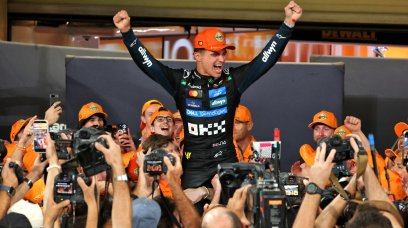Formula 1's 2022 cars were run in anger for the first time at this week's Barcelona pre-season test, and it did not take long before teams encountered a strange issue, which essentially led to their new designs bouncing along the track. A major change for the upcoming F1 season is the move from over-body downforce to a ground effect philosophy. This means downforce is predominantly generated by airflow under the car, essentially sucking it down to the ground. However, a side effect of the philosophy is that the car's natural frequency can cause resonance through the chassis – this could be spotted by cars bouncing or 'porpoising' down the straights on all three days of the test.
Porpoising creates headlines at F1 testing
Speaking in an exclusive interview with RacingNews365.com at the Circuit de Barcelona-Catalunya, Red Bull team boss Christian Horner raised concerns about the phenomenon and hopes fixes can be put in place. "We've got a lot of data, we've done a lot of laps and you're learning about how the ground effect is affecting the cars," Horner explained as the first test drew to a close. "You can see the porpoising is an issue for most teams, so it's a matter of understanding it." As for the team's veteran technical chief, Adrian Newey, who encountered porpoising at the beginning of his F1 career back in the 1980s, Horner said: "That's the benefit of experience, and he has plenty of it!"
1496888665431326726
Bumpy road to the top for Charles Leclerc! #F1 pic.twitter.com/Z6a5e6d3bo — Formula 1 (@F1) February 24, 2022
Horner fears a potential "safety issue"
A problem for teams is that porpoising cannot be easily replicated on the simulator or in the wind tunnel, meaning there is now even more emphasis on track data. Asked what teams are able to do to manage the situation, Horner said: "I think there are [still] certain tools that we can use that can recreate [it]. "With the data that we're collecting off the car as well, it gives you an understanding, and good old flow-vis [paint], there's plenty of that going on the cars at the moment!" While it should, in theory, be relatively easy to get on top of porpoising, changes to alleviate the problems would come at the expense of downforce, and therefore performance. Asked if teams will be able to recover lost downforce by curing the porpoising effect, and still maintain speed, Horner declared that to be "the trick". If not, it could become a safety issue moving forward, with Horner commenting: "The teams need to get it under control before we end up at circuits like [Baku in] Azerbaijan or some of the very high-speed [circuits]. "I think it's going to be worse [in Bahrain] than here [in Barcelona] and Saudi Arabia could be an issue as well."
An unintended consequence of F1's new era
Horner feels that porpoising was perhaps overlooked when F1's new generation of cars were being developed, and also pointed to increased weight – with almost 50kg being added to the 2022 machines compared to last year. "The cars are a fair bit heavier; I think every team is struggling to get to the [minimum] weight, from what I understand," he added. "I think it's an unintended consequence, but on the positive side, the reports from drivers are that [when] following the wake of another car, you're less disturbed than you were last year. "Certainly, Max [Verstappen] felt that there was the ability to follow more closely and less interrupted compared with the 2021 car, so I think you have to take that as a positive to suggest there will be more overtaking and more racing."
Most read






